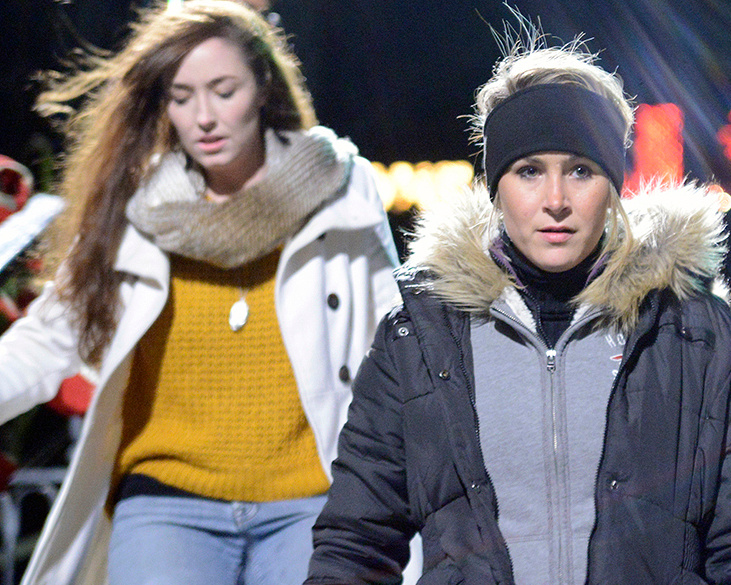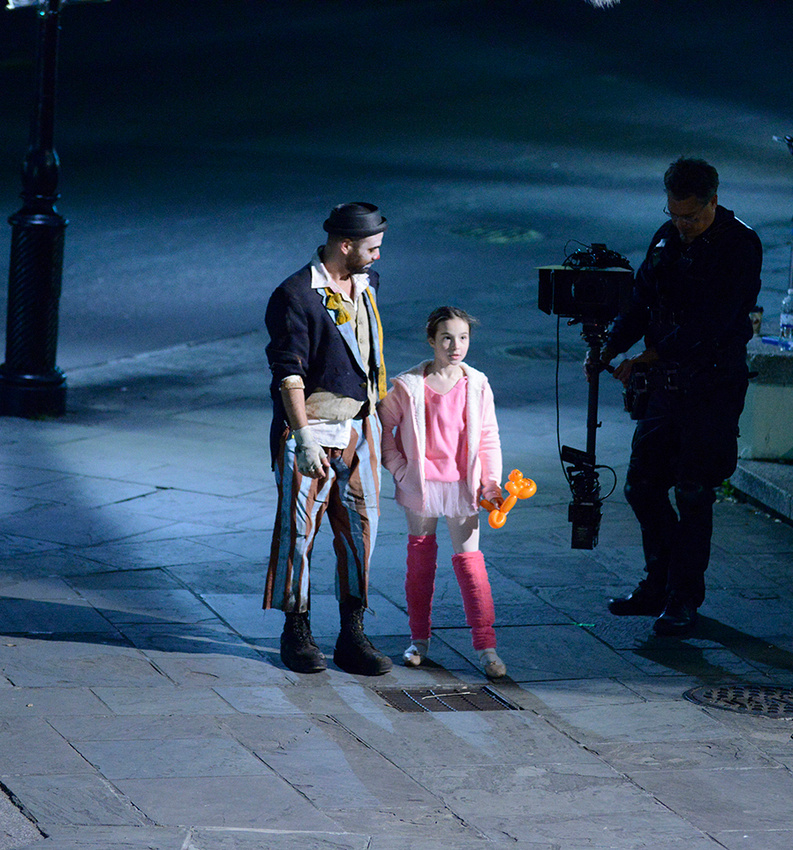WRAP ARTISTS: What America's Newest Filmmakers From UNO Taught Me About the Reel World
(Writer-director Dawn Spatz, right, bounds down the steps of Artillery Park in New Orleans' Jackson Square, followed by actress Chelsea Hebert, to rehearse a nighttime scene during the filming of "The Horse and the Castle," her University of New Orleans MFA graduate thesis film.)
It isn’t often that an old dog gets to learn new tricks -- not just the technical variety but also the emotional kind that opens the eyes to the immense creativity in others. But then I’ve never before been surrounded by amazingly talented graduate and undergraduate film students with a gift and passion for cinematic storytelling. But I’m getting ahead of myself.
As part of my baby steps toward gaining a foothold in the competitive world of unit stills photography, Scene Magazine editor-in-chief Micah Haley (www.scenelouisiana.com) wisely suggested I get my feet wet by volunteering to shoot a couple of independent thesis films being produced by third-year MFA graduate students in the University of New Orleans’ Department of Film, Theater and Communication Arts. He put me in touch with Dr. Hamp Overton, associate professor of film, who in turn forwarded my email volunteering my skills to third-year graduate students.
Initially, I thought this was going to be a pretty straightforward quid pro quo arrangement: I volunteer to shoot unit stills for a day for a student's film, providing him/her with the resulting images, and in return I pad my portfolio with movie-scene content and parlay the images into paying gigs in multimillion-dollar feature-length films. Instead, I came away with something of even greater value. Namely, an immense respect for the caliber of highly trained, disciplined and creative filmmakers I met. While many people in New Orleans are no doubt familiar with UNO’s film program, I have a hunch few are acquainted with the sheer level of professionalism I witnessed while shooting unit stills for “Galatea,” written and directed by Jared Stanton (www.facebook.com/Galateafilm/info; http://www.imdb.com/name/nm4691763/), and “The Horse and the Castle,” written and directed by Dawn Spatz (www.facebook.com/TheHorseAndTheCastle; http://www.imdb.com/name/nm3487232/).
With camera blimp and lens tubes in hand (read more about this here: http://jamesgaffneyphotography.zenfolio.com/blog/2012/11/quiet-on-the-set), I ventured tepidly into what for me was the new realm of movie sets, this after decades spent as a travel photojournalist and 21 years as a staff writer and photographer at The Times-Picayune, the-then daily newspaper of New Orleans. While the term “student film” didn’t necessarily conjure images of people running about with hand-held camcorders, I’ll be the first to admit that what I didn’t expect to find was this ...
("Galatea" writer-director Jared Stanton, far left, looks on as a camera dolly crew rehearses for a scene to be shot in the Warehouse District of New Orleans.)
… or this ...
(From right to left: Sound mixer Jack Bigelow and steadicam operator Ralph Madison trail actress Juliette Enright up the steps of Artillery Park in New Orleans' Jackson Square while filming a scene for "The Horse and the Castle," written and directed by Dawn Spatz.)
NO-MAN ON THE TOTEM POLE As a unit stills photographer -- the person who shoots photographs used for publicity, press kits, movie posters, or to merely document the filmmaking process -- you have to know how to keep out of the way and, most importantly, out of frame. In terms of film-crew hierarchy you’re essentially the no-man on the totem pole, if you will, because you’re not involved in creating anything actually related to the movie -- not the lighting, sets, costumes, makeup, directing, etc. Nada. Zip. Your goal is to sweep in after the fact, as stealth-like as possible, and, if you do your job right, nail perfect cinematic moments (probably while shooting directly beside the camera operator) that dozens of talented people working in concert have spent hundreds of hours to create. As a unit stills photographer, you stand on the shoulders of the brilliant work of others.
It doesn't hurt to nail a few candids of the cast and crew along the way (always mindful not to get the way or disrupt anyone's focus), which is fun because behind-the-scenes stuff offers a glimpse into the non-stop hard work -- we're talking 10- to 18-hour days here -- that goes into creating the magic of the final creative product. As “The Horse and the Castle” writer-director Dawn Spatz told me the first night I worked on her set at the UNO sound stage, “You’re like a ninja.” I took this as a compliment. (Note: I've since purchased a pair of black military cargo pants like those worn by steadicam operator Ralph Madison because they are ridiculously ninja and ideal for the set. For shooters, dark clothing is a must -- preferably black until someone comes up with a darker color.)
On rare occasions when time permits, you have the pleasure of assembling cast and crew for a group shot, as I did below on the set of "Galatea." But you have to work fast -- from the time it took to arrange the crew using my best slap-dash version of an Annie Leibovitz group set-up, grab a ladder to stand on and actually snap the photograph was less than five minutes.
(Above, the cast and crew of "Galatea.")
Among the best aspects of working as a lone wolf alongside a talented crew is training your lens on what at times can be breathtakingly beautiful and stirring moments of filmmaking. Such was the case during a scene in “The Horse and the Castle” (below) when a father (played by Hunter Burke) attempts to comfort his young daughter (Juliette Enright) when she is confronted by her parents’ pending divorce.
And, below, the reaction of the mother (played by Chelsea Hebert) when she enters her daughter's bedroom.
On the set of "Galatea," photographing actor Michael Krikorian proved a revelation. He reminded me of a young Jack Lemmon -- spontaneous, expressive and intense -- during his scenes in which he plays a photographer so obsessed with artistic perfection that he has lost his ability to connect with humanity.
(Actor Michael Krikorian, as "Eric," kneels to photograph a flower during the filming of "Galatea" in the Warehouse District of New Orleans. In the background is boom operator Alex Aaron and, far right, Jared Stanton.)
FIRED ON THE SPOT? If you're an aspiring unit stills photographer, don't even bother stepping off the bus unless you possess the kind of personality that enables you to work well with a broad spectrum of intensely creative types -- and, especially, the first assistant director (or 1st AD), who runs the "floor" (or set). As a well-known, long-time Hollywood unit stills photographer warned on his blog: “P*ss off the 1st AD and you’re toast.” Fortunately this newbie had the good fortune to work with two generous and extremely patient 1st ADs -- Lee Garcia (“The Horse and the Castle”) and Lizzie Guitreau (“Galatea”). I'll confess that on a couple of occasions I did in fact accidentally wind up in frame during a shoot. And they gently told me so and instructed me where to stand for the next take. I was lucky. Had this been a multimillion-dollar feature-length film, I could have been fired on the spot. No questions asked -- no explanations given. But I also got the chance to learn about the critical role the 1st AD plays as the glue that holds everything together while also watching out for the welfare and safety of cast and crew. Don’t ask me how, but these multi-taskers extraordinaire are omnipresent – they can literally seem to be everywhere on the set simultaneously. To Lee and Lizzie, I owe a debt of gratitude.
(Top, Lee Garcia, 1st AD for "The Horse and the Castle"; above, Lizzie Guitreau, right, 1st AD for "Galatea," confers with writer-director Jared Stanton.)
Call me biased for believing the University of New Orleans’ Department of Film, Theater and Communication Arts is producing what certainly must be among the brightest new filmmakers in the country today. No, I haven’t visited similar graduate film productions at NYU, Columbia, USC, UCLA, etc., so I have nothing on which to base my belief other than my limited first-hand experience and newfound pride in the New Orleans students that allowed me the honor of working alongside them if only for a few brief shining moments -- the students that became my teachers.
(From right to left: Steadicam operator Ralph Madison shoots a nighttime scene with Juliette Enright and Jackson Beals during filming of "The Horse and the Castle.")
Keywords:
1st AD,
Chelsea Hebert,
Dawn Spatz,
Galatea,
Jared Stanton,
MFA graduate thesis film,
Michael Krikorian,
The Horse and the Castle,
University of New Orleans,
director,
unit stills photography
Comments
No comments posted.
Loading...
|










